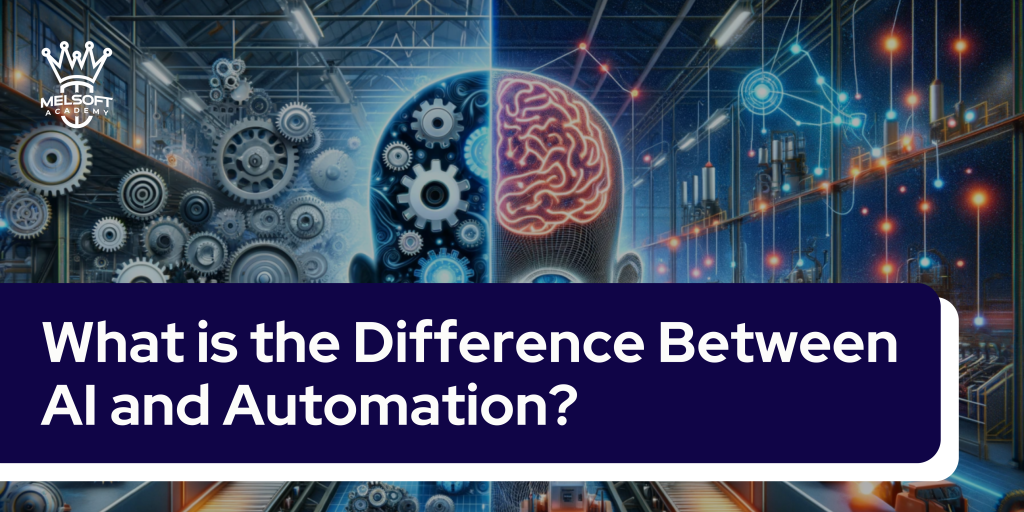Key Takeaways
- Understanding Definitions: Automation refers to the execution of repetitive tasks without human intervention, while AI simulates human cognitive functions to learn and adapt.
- Integration Benefits: AI and automation together create efficiencies that enhance productivity, reduce costs, and enable better decision-making.
- Human Role: Despite advancements, human insight and creativity remain essential in guiding and overseeing AI and automation processes.
- Applications Across Industries: Both technologies are utilized across various sectors, including healthcare, finance, manufacturing, and customer service, driving innovation and efficiency.
- Future of Work: The integration of AI and automation is not about replacing humans but augmenting their capabilities, leading to new opportunities and roles.
Introduction
In today’s rapidly evolving technological landscape, the terms “automation” and “artificial intelligence” (AI) are often used interchangeably. However, understanding the fundamental differences between these two concepts is crucial for businesses and individuals alike. While both automation and AI aim to improve efficiency and productivity, their mechanisms and applications are distinctly different.
This blog post will explore what automation and AI are, how they function, and how they can be effectively integrated to enhance performance across various industries. We’ll also examine the indispensable role of humans in this equation, ensuring that technology serves as a tool to empower rather than replace.
What is Automation?
Definition of Automation
Automation can be defined as the use of technology to perform tasks with minimal human intervention. It involves predefined processes and rules that enable machines or software to execute repetitive tasks consistently and efficiently.
Key Features of Automation
- Repetitive Tasks: Automation excels at handling tasks that require repeated actions or specific sequences.
- Minimal Human Input: Once set up, automated systems operate independently, requiring little to no manual oversight.
- Efficiency: By streamlining processes, automation can significantly enhance productivity and reduce errors.
Common Uses of Automation
Automation is prevalent in various industries, performing tasks such as:
- Manufacturing: Automated assembly lines increase production speed and accuracy.
- Data Entry: Tools like Optical Character Recognition (OCR) streamline data extraction from documents.
- Customer Service: Automated chatbots handle routine inquiries, providing quick responses without human involvement.
Benefits of Automation
Implementing automation leads to numerous advantages, including:
- Increased efficiency and productivity.
- Reduced operational costs.
- Improved accuracy and consistency in processes.
What is Artificial Intelligence?
Definition of AI
Artificial intelligence refers to a broad category of technologies designed to simulate human cognitive functions. This includes the ability to learn, reason, and make decisions based on data input.
Key Features of AI
- Learning Ability: AI systems can analyze vast datasets, learn from them, and improve over time.
- Reasoning: AI can draw conclusions and make decisions based on logical inference.
- Problem-Solving: AI is adept at identifying and resolving complex issues using algorithms.
Common Applications of AI
AI is increasingly integrated into various services and industries, including:
- Healthcare: AI aids in medical diagnosis and personalized treatment plans.
- Finance: AI detects fraudulent transactions and enhances trading strategies.
- Customer Experience: AI personalizes interactions through recommendation systems and sentiment analysis.
Benefits of AI
The integration of AI into business processes offers several benefits:
- Enhanced decision-making with data-backed insights.
- Increased innovation and adaptability to changing market conditions.
- Improved customer engagement through personalized experiences.
How AI and Automation Work Together
Integration of AI and Automation
While automation efficiently executes predefined tasks, it often lacks the ability to make complex decisions that require interpretation of data. This is where AI comes into play. By combining AI with automation, businesses can create intelligent systems that enhance their operational capabilities.
Practical Example
Consider a scenario where a company uses automation to manage content publishing. An automated workflow might post articles to a website based on a schedule. However, if the company wants to categorize each article based on its content, it would need AI to analyze the text and determine the appropriate category before posting.
Benefits of Integration
The synergy between AI and automation leads to:
- Enhanced Efficiency: Automation handles routine tasks while AI provides insights and decision-making capabilities.
- Operational Resilience: Businesses can quickly adapt processes based on AI predictions and data analysis.
- Cost Savings: Organizations can reduce costs by streamlining operations and improving customer experiences.
Where Do Humans Fit Into All of This?
The Human Element
Despite the advancements in AI and automation, the human element remains irreplaceable. Technology is a tool that enhances human capabilities rather than replaces them.
Roles for Humanss are essential in areas that require:
- Critical Thinking: Tasks that involve complex reasoning and unique problem-solving.
- Relationship Building: Roles that depend on interpersonal skills and emotional intelligence.
- Oversight and Control: Ensuring that automated systems and AI operate within ethical and operational guidelines.
Conclusion on Human-AI Collaboration
The future of work lies in the collaboration between humans and technology. By leveraging AI and automation, individuals can focus on high-value tasks that require creativity and strategic thinking, ultimately leading to greater job satisfaction and productivity.
Conclusion
In summary, while automation and AI are often conflated, understanding their distinct roles is essential for effective implementation in various industries. Automation excels at executing repetitive tasks, whereas AI provides the cognitive abilities needed to analyze data and make decisions. Together, they create a powerful synergy that enhances efficiency, drives innovation, and improves overall business performance.
At Melsoft Academy, we empower individuals to harness the potential of these technologies through our comprehensive training programs. Whether you’re looking to upskill or pivot your career towards the tech industry, we offer bootcamps designed to equip you with the necessary knowledge and skills.
Take the first step towards your dream job!
Apply Now: Browse Our Bootcamps
Download our Prospectus: Download Now
FAQ Section
1. What is the main difference between automation and AI?
Automation involves executing predefined tasks without human intervention, while AI simulates human intelligence to learn and make decisions.
2. Can AI operate without automation?
Yes, AI can function independently for tasks like data analysis and decision-making, but it often works best when integrated with automation for efficient task execution.
3. How does automation improve business efficiency?
Automation reduces the time and effort required for repetitive tasks, leading to increased productivity and fewer errors.
4. What industries benefit the most from AI and automation?
Industries such as healthcare, finance, manufacturing, and customer service significantly benefit from AI and automation through enhanced efficiency and improved decision-making.
5. Are AI and automation the same in terms of technology?
No, they represent different technologies. Automation focuses on task execution, while AI focuses on simulating human cognition and decision-making.
6. How can businesses integrate AI and automation?
Businesses can integrate AI and automation by identifying repetitive tasks that require decision-making and applying AI solutions to enhance those workflows.
7. What skills are needed to work in AI and automation?
Skills in data analysis, programming, machine learning, and an understanding of business processes are essential for careers in AI and automation.


